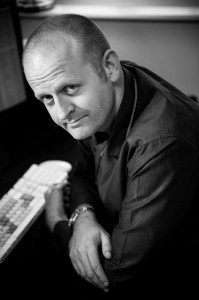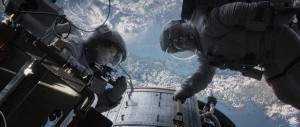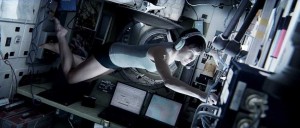
Editor Mark Sanger, with his background in both picture and visual effects editing, was the perfect collaborator to team with writer/director/editor Alfonso Cuarón on the auteur’s 3D space survival drama, Gravity, starring Sandra Bullock and George Clooney. Because the story takes place in earth orbit, the seamlessly realistic environment for the film needed to be crafted through a combination of animation and visual effects.
“To be honest, the challenge at the beginning was that we had no idea of how to do it,” revealed Sanger. Normally filmmakers have an idea of how to go about making a film, but because the way of telling this story was so unique, the director, editor storyboard artists and visual effects team conferred in pre-production to figure out how the film would go together, what it would look like, what the basic blocking would be, and how they would achieve that creative vision. “It was very useful to communicate with each other,” said Sanger, “because we were basically designing a machine as we were going.”
The workflow for creating the visual effects-based film combined pre-production, production and post into one overlapping three-year process using methods that were closer to those used for animation films than typical live-action movies. Editing started off by putting rough guide sequences together using storyboards and basic pre-viz animation with Sanger temping Clooney’s dialog and his assistant filling in for Bullock.

“Even at that stage, Alfonso had to be in four places at once,” explained Sanger. “Certainly, I was designing the technical background to the whole editorial process with my assistant in conjunction with the other departments. The creative side was kind of in its infancy. To a certain extent, Alfonso let me get on with that, because at that stage he needed to progress with the animation and logistical issues.”
As the workflow evolved, Cuarón and Sanger got together more and more as it became clear to them that a majority of the editing – about 90 percent – would need to be done to a certain level during the pre-visualization phase prior to the shoot. “Alfonso was sitting and working with me and running across to the animation guys to re-block the scene with them. He’d then come back to editorial with fresh shots and fresh animation,” shared Sanger. “He is kind of editing in his head as he is jumping between the visual effects guys and editorial.”
 Sanger’s job was to keep track of the shots moving back and forth between the editing and VFX departments. He also had to stay one step ahead of the game with Cuarón, which Sanger admitted, “Was a tricky thing to do with a man whose brain works at that speed.” To keep moving the film forward, editorial needed to be the heart of the process both technically and creatively. In order to have something to shoot and before the cast even signed on, the team gradually honed the edit to a level of intricacy and detail beyond what would be normal at this phase of a production. “The frustrating thing for us is that this went on for about 18 months and we didn’t even have a green light from the studio,” revealed Sanger.
Sanger’s job was to keep track of the shots moving back and forth between the editing and VFX departments. He also had to stay one step ahead of the game with Cuarón, which Sanger admitted, “Was a tricky thing to do with a man whose brain works at that speed.” To keep moving the film forward, editorial needed to be the heart of the process both technically and creatively. In order to have something to shoot and before the cast even signed on, the team gradually honed the edit to a level of intricacy and detail beyond what would be normal at this phase of a production. “The frustrating thing for us is that this went on for about 18 months and we didn’t even have a green light from the studio,” revealed Sanger.
Once Bullock and Clooney signed on, the process evolved from the more technical period, into a more conventional, creative editorial as the team incorporated the actors’ performances. In the months before the shoot, editorial swapped out the temp tracks with sit-down dialog from the stars. “That gave us a lot of answers as to how the actors’ performances would be affecting the pre-edit that we had been working on,” said Sanger. “The nature of the shoot was that they would be a lot more restricted than actors normally are. They’d come to set in the morning, see the shot in the cut that we were going to do that day. They would shoot that shot and that shot only, doing a number of different takes.” It took about another eight or nine months from the time the actors came on board through the course of production. Almost two years had passed before the film hit what would normally be considered “postproduction proper.”
 To incorporate the performances into the animated sequences, a piece of hardware – the Light Box – was built which would effectively put the actors into the same blocked movements that had been animated. “On the easier shots, I had this wonderful delight of taking the actors performances and literally applying them to the existing animation in the cut,” said Sanger. “Having the practical shoot and the animation in perfect synchronicity – the actors would be moving with the animation – it was a thing of beauty. At that stage the edit had life, but it did not have any of the beauty of the visuals from the final movie. That was months down the line.” The team then molded the film into the best performances that they were getting from the actors. All of this performance work had to be done before adding the lighting and details to all the shots and cuts.
To incorporate the performances into the animated sequences, a piece of hardware – the Light Box – was built which would effectively put the actors into the same blocked movements that had been animated. “On the easier shots, I had this wonderful delight of taking the actors performances and literally applying them to the existing animation in the cut,” said Sanger. “Having the practical shoot and the animation in perfect synchronicity – the actors would be moving with the animation – it was a thing of beauty. At that stage the edit had life, but it did not have any of the beauty of the visuals from the final movie. That was months down the line.” The team then molded the film into the best performances that they were getting from the actors. All of this performance work had to be done before adding the lighting and details to all the shots and cuts.
“The crucial thing for editorial was all about letting the strong performances drive the story,” said Sanger. Cuarón was particular about the vocal performance, shaping it in the picture edit. A lot of dialog work was done to maximize Bullock’s performance when her voice is heard off camera. The director spent two weeks in the final mix addressing her breath. “I’ve worked with Alfonso before and know he works with that level of detail,” commented Sanger. “Attention to detail is what immerses you in the screen.”
“If any of us had stopped at any particular point during the whole process to consider how mind-boggling what we were doing was, I think we would have gone mad because the task was so awesome,” said Sanger. “At times it really did feel like the film would go on forever.”





